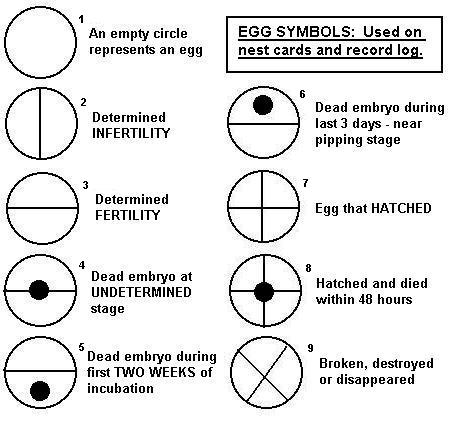
Egg Symbols
Searching through records seems to be a function of humanity that brings to light the information which provides answers to the age old questions of ... Who?, What?, When?, Where?, and Why? In most cases, the answers are only as good as the information available. Such record entries may have uncertain value to some.The chart below shows nine (9) symbols used in my pigeon breeding records. Each entry starts with one of these symbols for a quick assessment of the production of a breeding pair. Written notes are also included for each egg/squab.

Fertility can be determined after a week (or less) of incubation. The stage of embryonic development may have to be determined after the incubation process is completed, and breaking the egg often becomes necessary. Actual or approximate hatch dates are written by the hatched symbol (7). The approximate hatch dates are followed by a question mark (?). Symbol 4 is used less often, and symbol 8 is often superseded by written notes.Explanations of symbols:
- When eggs are laid make a small circle to represent each egg.
- Later - if infertile, mark with a vertical line.
- Later - if fertile, mark with a horizontal line.
- Later - undetermined development, make a dot on the horizontal line.
- Later - if embryo died early, make a dot beneath the horizontal line.
- Later - if embryo died near hatching, make a dot above horizontal line.
- If egg hatched, draw a vertical line through the horizontal line.
- If squab dies with 48 hours, make a dot where lines cross.
- If egg is lost, broken or disappears (new squab), make an X in circle.
An X can be superimposed over any symbol, including hatched (7).